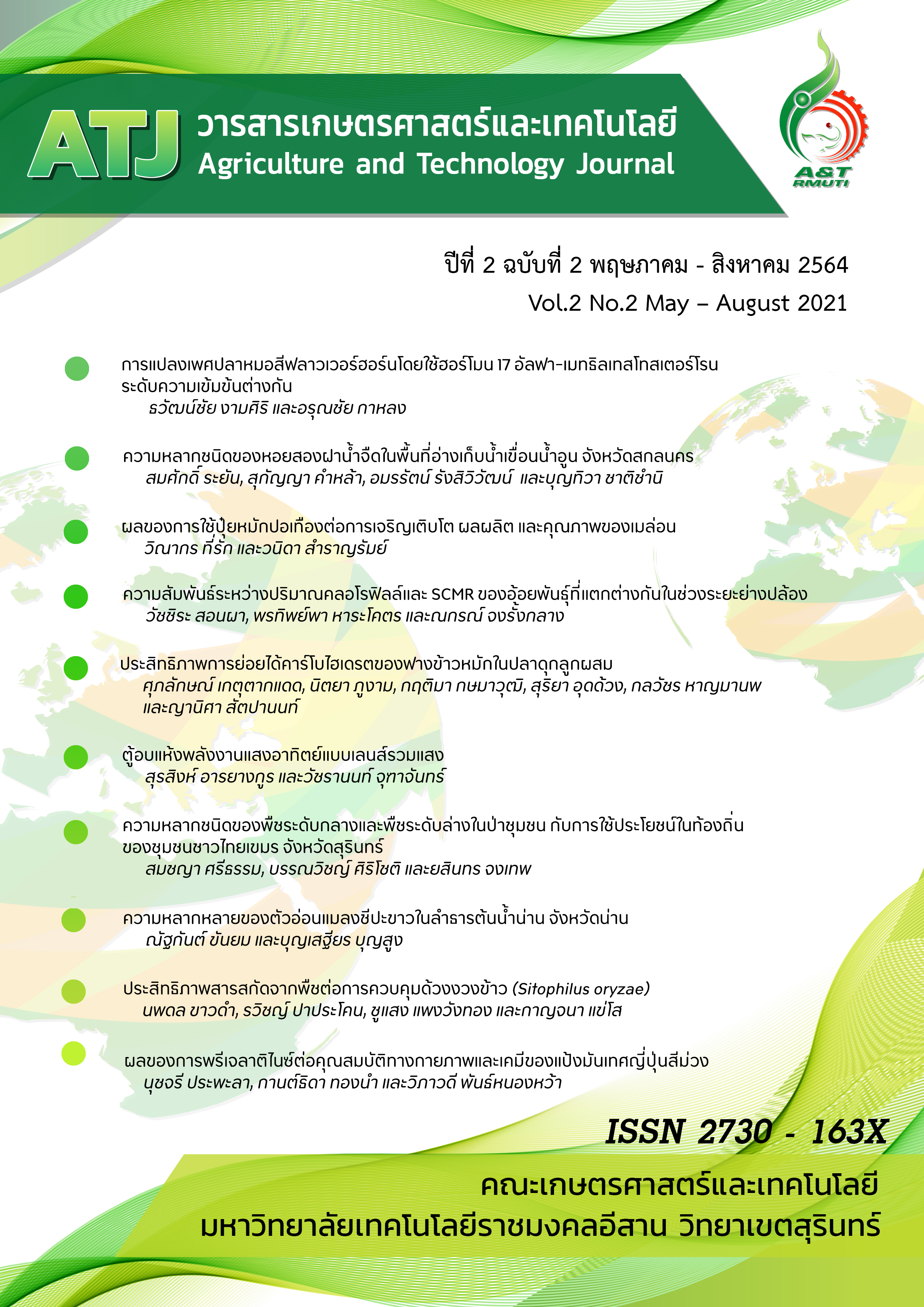Efficacy of plant extracts for controlling of rice weevil (Sitophilus oryzae)
Keywords:
Rice weevil, Control, Plant extract, Black pepperAbstract
Rice weevils (Sitophilus oryzae) are one of the most important insect pests. This insect cause serious damage in stored agricultural product in terms of quality and quantity damages. Currently, the organic rice is produced. Therefore, plant extracts are used for control of insect pest during the organic rice production process. This study examined the efficacy of 6 plant extracts including black pepper (Piper nigrum), tobacco (Nicotiana tabacum), neem (Azadirachta indica), turmeric (Curcuma longa), galangal (Alpinia galangal) and kaffir lime leaves (Citrus hystrix) as a control agent for rice weevils, S. oryzae.The plant extract concentration was 1,000,000 mg/L. A complete randomized trial (CRD) was planned for 7 treatments with 4 replications. The insects were used in the adult stage of 10 individual per replication. The results showed that the crude extracts from plants showedstatistically significant different efficacy for control of rice weevils (p<0.001). Black pepper extracts were the most effective in killing rice weevils of 100%, followed by tobacco and neem extract with 27.5% and 20.0%, respectively, which were statistically significant different from the control treatment using water (p<0.001). Rice weevils have an increasing cumulative mortality rate after exposure with plant extracts. The black pepper extract showed the highest insect mortality rates after spraying for 24, 48, 72 and 96 hours of 72.5%, 87.5%, 97.5% and 100%, respectively. The turmeric, galangal and kaffir lime leaves extracts did not have significant different with the percentage of insect mortality compared to the water treatment. Moreover, none of insect death was found after spraying with galangal and leech lime leaf extracts. Our result conclude that black pepper extracts can be use in the control of important agricultural pests to reduce the use of chemical.
References
กระทรวงเกษตรและสหกรณ์. (2560). มาตรฐานสินค้าเกษตร: ข้าวหอมมะลิไทย. 221. 1-34.
กันยารัตน์ มาแย้ม, อรพิน เกิดชูชื่น และณัฎฐา เลาหกุลจิตต์. (2556). ประสิทธิภาพของสารสกัดจากพืช 10 ชนิด ในการเป็นสารไล่ด้วงงวงข้าวโพด. วารสารวิทยาศาสตร์เกษตร. 44(2): 25-28.
ณฐพงศ์ เมธินธรังสรรค์ และดวงเดือน วัฏฏานุรักษ์. (2561). ผลของสารสกัดหยาบจากใบสาบเสือในการควบคุมแมลงวันผลไม้ Bactrocera dorsalis (Hendel) (Diptera: Tephritidae). วารสารวิจัยรำไพพรรณี. 12(2): 102-109.
ณัฏฐพร อุทัยมงคล. (2559). มาตรการสุขอนามัยพืชในการส่งออกสินค้าเกษตร. รายงานการวิจัย. กรมวิชาการเกษตร กรุงเทพฯ.
นภัส ยิ้มกรุง, วีรเทพ พงษ์ประเสริฐ, ปาณิสรา เทพกุศล, ไสว บูรณพานิชพันธ์ุ และเยาวลักษณ์ จันทร์บาง. (2562). พลวัตประชากรและการควบคุมมอดข้าวเปลือกในโรงเก็บเมล็ดพันธุ์ข้าว. วารสารเกษตร. 35(2): 295–302.
นันท์นภัส พิริยะอนนท์. (2560). ประสิทธิภาพสารสกัดพืชต่อการควบคุมมอดข้าวสาร (Sitophilus oryzae L.) ในข้าวอินทรีย์. วิทยานิพนธ์ปริญญาวิทยาศาสตรมหาบัณฑิต สาขาวิชาการจัดการเกษตรอินทรีย์ คณะวิทยาศาสตร์และเทคโนโลยี มหาวิทยาลัยธรรมศาสตร์.
บุญยาพร สระทองรอด และฤชุอร วรรณะ. (2564). ความเป็นพิษของน้ำมันหอมระเหยจากพืชวงศ์กะเพราะ (Lamiaceae) ป้องกันกำจัดแมลงศัตรูในโรงเก็บ. วารสารเกษตรพระวรุณ. 18(1): 112-119.
ปัณรสี สู่ศิริรัตน์. (2559). ประสิทธิภาพของสารสกัดจากเปลือกว่านหางจระเข้ในการควบคุมหนอนใยผัก. วารสารเกษตร. 32(3): 369-378.
ฤชุอร วรรณะ และมงคล วงศ์สวัสด์. (2561). ประสิทธิภาพของน้ำมันหอมระเหยพืชสมุนไพร 3 ชนิด ป้องกันกำจัดด้วงงวงข้าวโพด. วารสารแก่นเกษตร. 46(1): 719-724.
ศุภจิต ผ่องใส. (2551). การพัฒนาบรรจุภัณฑ์ข้าวสารป้องกันด้วงงวงข้าวโพดโดยการเคลือบน้ำมันหอมระเหย. วิทยานิพนธ์ปริญญามหาบัณฑิต. สาขาวิชาเทคโนโลยีการพิมพ์และบรรจุภัณฑ์ คณะครุศาสตร์อุตสาหกรรมและเทคโนโลยี มหาวิทยาลัยเทคโนโลยีพระจอมเกล้าธนบุรี.
ศูนย์นวัตกรรมเทคโนโลยีหลังการเก็บเกี่ยว. (2558). การเข้าทำลายของแมลงศัตรูข้าวเปลือกแบบบรรจุกระสอบระหว่างการเก็บรักษา. ค้นเมื่อ 16 มิถุนายน 2563. http://www.phtnet.org/newsletter/?mod=download&id=40.
สํานักวิจัยและพัฒนาข้าว. (2559). การเก็บรักษา สํานักวิจัยและพัฒนาข้าว กรมการข้าว. ค้นเมื่อ 16 มิถุนายน 2563. http://www.brrd.in.th/rkb/postharvest/().
Hassan A. M., Ahmed A. M. and Mohammed S. A. (2018). Eco-friendly tools for controlling of the rice
weevil Sitophilus oryzea (Coleoptera: Curculionidae). Alexandria science exchange. 39(3): 482-492.
Martin O. U., Jephtha C. N., Bernard C. O. and John E. A. (2017). Toxicity of lemon grass Cymbopogon
citratus powder and methanol extract against rice weevil Sitophilus oryzae (Coleoptera:Curculionidae). Coastal Life Medicine; 5(3): 99-103.
Rajapakse, R. H. S. (2006). The potential of plants and plant products in stored insect pest management. The Journal of Agricultural Sciences, 2(1): 11-21.
Samir A. M. A., Magdy I. E. M., Mohamed S. S. and Hamdy K. A. (2016). Chemical composition, insecticidal and biochemical effects of essential oils of different plant species from Northern Egypt on the rice weevil, Sitophilus oryzae L. Pest Science. 89: 219-229.
Souza V.N.D., Carlos R.F.D.O., Claudia H.C.M. and Daiany K.F.D.A. (2016). Fumigation toxicity of essential oils against Rhyzopertha dominica (F.) in stored maize grain. Revista Caatinga. 29(2): 435-440.
Tapondjou A.L., Adler C., Fontem D.A., Bouda H. and Reichmuth C. (2005). Bioactivity of cymol and essential oil of Eucalyptus saligna and Cupressus sempervirens against Sitophilus zeamais Motschulsky and Tribolium confusum du val. Stored Products Research. 41: 91-102.
Ukeh D.A., Sylvia B.A.U., Alan S.B., Jennifer M.L.A., John A.P. and Michael A.B. (2012). Alligator pepper, Aframomum melegueta and ginger, Zingiber officinale, reduce stored maize infestation by the maize weevil, Sitophilus zeamais in traditional African granaries. Crop Protection. 32: 99-103.
Yoon C., Kang S.H., Jang S.A., Kim Y.J. and Kim G.H. (2007). Repellent efficacy of caraway and grapefruit oils for Sitophilus oryzae (Coleoptera: Curculionidae). Asia Pacific Entomology. 10: 263–267.
Zhou B.G., Wang S., Dou T.T., Liu S., Li M.Y., Hua. R.M., Li S.G. and Lin. H.F. (2016). Aphicidal activity of Illicium verum fruit extracts and their effects on the Acetylcholinesterase and Glutathione S- transferases Activities in Myzus persicae (Hemiptera: Aphididae). Insect Science. 16(1): 1–7.
Downloads
Published
Versions
- 2024-02-15 (2)
- 2021-08-30 (1)
How to Cite
Issue
Section
License
Copyright (c) 2021 Agriculture and Technology Journal

This work is licensed under a Creative Commons Attribution-NonCommercial-NoDerivatives 4.0 International License.
เนื้อหาและข้อมูลในบทความที่ลงตีพิมพ์ในวารสารทดสอบระบบ ThaiJo2 ถือเป็นข้อคิดเห็นและความรับผิดชอบของผู้เขียนบทความโดยตรงซึ่งกองบรรณาธิการวารสาร ไม่จำเป็นต้องเห็นด้วย หรือร่วมรับผิดชอบใดๆ
บทความ ข้อมูล เนื่อหา รูปภาพ ฯลฯ ที่ได้รับการดีพิมพ์ในวารสารทดสอบระบบ ThaiJo2 ถือเป็นลิขสิทธิ์ของวารสารทดสอบระบบ ThaiJo2 หากบุคคลหรือหน่วยงานใดต้องการนำทั้งหมดหรือส่วนหนึ่งส่วนใดไปเผยแพร่หรือเพื่อกระทำการใดๆ จะต้องได้รับอนุญาตเป็นลายลักอักษรณ์จากวารสารทดสอบระบบ ThaiJo2 ก่อนเท่านั้น







